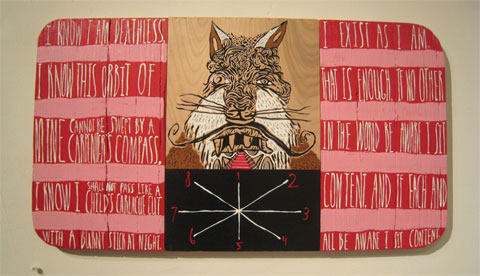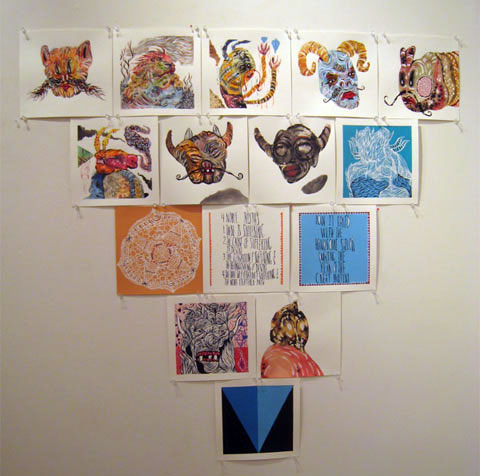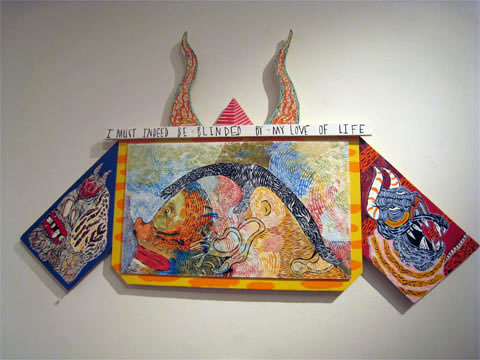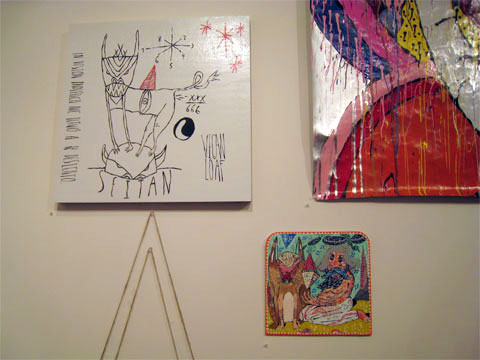I walked through SFMoMA last Friday, intent on scoping out the three big shows currently there: Joseph Cornell, Jeff Wall, and Olafur Eliasson. Here are some thoughts:
- The Cornell show is on the third floor, which is normally the photography galleries, and has been that way since the museum opened. I normally walk through the museum like a trained rat, knowing what era or medium will be in which gallery. It was a little disorienting.
- All three shows are in dimly lit or dark galleries. Man, that's hard on my eyes. Here we are having a wonderful streak of beautiful November weather, and I feel like I'm wasting the day at a matinée. But I understand why the lights are low:
- Cornell's materials are vulenerable to exposure;
- Wall's light box photos need the lights dimmed;
- Eliasson fun house installation depends controlled lighting.
- Each of the shows involves a very different kind of looking, a different sense of scale to the body, and a different kind of space:
- Cornell's space is close and intimate-- the head or face is in relation to the object;
- Wall's is the public space of outdoor advertising-- the body in relation to the object;
- Eliasson's is environmental-- the body in the object, and a kind of rubbing together of nature and architecture, which I guess would be something along the lines of landscape architecture or environmental planning.
- They finally changed the paintings hanging in the Clyfford Still gallery! Nothing to do with Cornell, Wall, or Eliasson, but I thought it was worth mentioning.
More thoughts on Joseph Cornell
I thought I knew Cornell's work pretty well, the collages and boxes and films and drawers full of photographs and ephemera, but I was wrong. Of course there is the myth about him as the obsessive naif, and I suppose I bought into that. But this exhibition shows him as an artist with extreme focus and clarity of vision, and the nerve and chops to realize his vision.
While Cornell's focus and vision might initially seem narrow, they were not simple; this work is complex in ways I don't think I can understand. It's mysterious, and layered, and cinematic. I think there is something in much of his images that is about capturing the feeling of singular moments in film- a moment or person of beauty, a certain juxtaposition, a movement, some kind of grandeur, something that happens in one moment in a film and then is gone; sitting in a dark theater watching moving images of projected light is thrilling, but certain moments in this medium can feel magical. I think Cornell was after that magic.
 That, and backyard astronomy, which is another kind of camera and cinematic experience. And celebrity worship, another kind of star gazing, And also the theater of the Peeping Tom or voyeur. And something that might look to us like nostalgia, but which was in Cornell's time the objects and images from his childhood, and from the generation just prior to him. These probably aren't original ideas on my part; they're probably in the literature, but Cornell's art definitely works in these many areas, as you can see for yourself.
That, and backyard astronomy, which is another kind of camera and cinematic experience. And celebrity worship, another kind of star gazing, And also the theater of the Peeping Tom or voyeur. And something that might look to us like nostalgia, but which was in Cornell's time the objects and images from his childhood, and from the generation just prior to him. These probably aren't original ideas on my part; they're probably in the literature, but Cornell's art definitely works in these many areas, as you can see for yourself.
Think of the Scrovegni Chapel, which is really one big box, and looking up at the ceiling, which is a deep cobalt blue above littered with gold stars, and substitute Lauren Bacall for Mary, and you're drifting towards Cornell.
It is a huge, impressive show, a bit of a landmark. The biggest surprise for me was seeing the skill with with Cornell made things. Components of some of the boxes are quite finely crafted, and there are collages that show genuine sophistication in terms of how color from different pieces are combined, how texture is laid next to another, how line and edge are used. This formal kind of stuff is something I did not expect to be bowled over by. He knew what he was doing.
The low light in the galleries combined with the amount of work can tire the observer, so plan your visit: at first, you might quickly walk through the show; next walk back through and carefully see the first half the show; after that, take a break at a cafe; finally, go see the rest of the show. Take your time-- it's worth it.
More thoughts on Jeff Wall
Lots of big photos, lots of light boxes. Most look staged, though there are a few where you can't quite tell for sure. I'm guess that they're all staged. OK, so it's tableau. It's artificial. No Henry Wessel or Diane Arbus here. We're talking Baroque.
It's great to see the beautiful Northwest, and interesting to see the lower middle classes making it big in 20th century art. Many of the people look a little downtrodden, and often wherever they are posed looks rundown, beat up, neglected. What are the images in these light boxes supposed to be selling? It doesn't look like a healthy product. Maybe they're public service announcements. I can't tell.
 Those light box images are kind of grainy looking-- bet they looked fantastic when they started showing up in the 80's. It's a funny thing about, say, Vermeer or Bouguereau or Seurat or whoever you want to name- a painting made two hundred years ago still has the same visual resolution as a painting made today. You know, no one at Sony's research labs is working on making paintings with a better resolution; every painting has 100% resolution, and always will... well, except for The Last Supper. But I think it's a little depressing, you know, the state of photography-- all those light boxes, and they already look like relics stored in a billboard company warehouse.
Those light box images are kind of grainy looking-- bet they looked fantastic when they started showing up in the 80's. It's a funny thing about, say, Vermeer or Bouguereau or Seurat or whoever you want to name- a painting made two hundred years ago still has the same visual resolution as a painting made today. You know, no one at Sony's research labs is working on making paintings with a better resolution; every painting has 100% resolution, and always will... well, except for The Last Supper. But I think it's a little depressing, you know, the state of photography-- all those light boxes, and they already look like relics stored in a billboard company warehouse.
Wait, am I looking at stills from some mid-80's TV show that I didn't know existed?
Wall wants to make paintings that have the impact of large paintings- impact in terms of size, and impact in terms of subject. He wants to be a history painter, like Jacques-Louis David or Charles Le Brun, but his history is that of the suburbs, the shabbily built and poorly planned, the oppression of being a capitalist worker pawn, the ordinary struggling person, our neighbor, how a fire engine pulls up to a house down the street we walk out on the porch and shyly watch from a distance.
They're spooky, and the size and the medium provide distance. We can look really closely without getting personally involved with anyone. We are witnesses with impunity. Whatever happens has so many witnesses that my testimony isn't needed. Something not so nice is going on, but there will never be any justice. That's the way things there.
We all know by now that photography lies. Knowing that Wall's work is a deliberate fabrication allows us to put that idea aside and to focus on a truth. The truth is that much of life is not glamorous. Most people, even famous people, still put their pants on one leg at a time. We are cruel and judgmental, although our conscience pushes us to overcome that base instinct. Wall's photos give us the opportunity to experience the distance between higher states-- consciousness and conscientiousness-- and more basic ones-- impulse, reaction, habit, and to observe how we move from one to the other. It's more cerebral than emotional, cool than hot. The notion is good; filling, but not that tasty.
More thoughts on Olafur Eliasson
Can anyone tell me why this show is better than anything at the Exploratorium? Sure, this is some family-friendly show. Makes you feel all good because you experience something kind of basic and pure and simple. But basically, it's purely simple backyard science-- fill a wading pool with water and drop rocks into it to watch rings collide and cross, and observe the shimmer of glimmering light on the pool's bottom.
 What is the big deal here? Didn't Lucas Samaras already do the mirrored room? Why isn't Larry Bell a God, rather than this latest Golden Boy. How is Eliasson's moss wall a better work than any Richard Long stone or mud installation? Why is this better art than sitting on the edge of the Grand Canyon watching a sunset? Why is this better than any waterfall? Why are major art institutions so enamored with this stuff? First Matthew Barney, and now this.
What is the big deal here? Didn't Lucas Samaras already do the mirrored room? Why isn't Larry Bell a God, rather than this latest Golden Boy. How is Eliasson's moss wall a better work than any Richard Long stone or mud installation? Why is this better art than sitting on the edge of the Grand Canyon watching a sunset? Why is this better than any waterfall? Why are major art institutions so enamored with this stuff? First Matthew Barney, and now this.
I don't care how many people laid on their backs in the Turbine Hall at the Tate gazing at the fake glowing sun of The Weather Project. This is some lazy stuff. And don't get me started on the BMW with the refrigerated exoskeleton-- you can keep your hi-tech message art.
What is with all of the clamor about this show? Why are people oohing and ah-ing? Geez people, go out on the balcony and walk through Barnet Newman's Zim Zum. Leave the museum, walk across Third Street, and enjoy the fountains at Yerba Buena Gardens.
Or, go back and walk through the Cornell show.
I like the groups of photos well enough, so some points there, but otherwise I can't even say, "Hey, Olafur, nice try." No Clapping Man-- he's napping.
===========================
All images borrowed from sfmoma.org
Joseph Cornell: Navigating the Imagination: Saturday, October 06, 2007 - Sunday, January 06, 2008
Jeff Wall: Saturday, October 27, 2007 - Sunday, January 27, 2008
Take your time: Olafur Eliasson: Saturday, September 08, 2007 - Sunday, February 24, 2008



















































